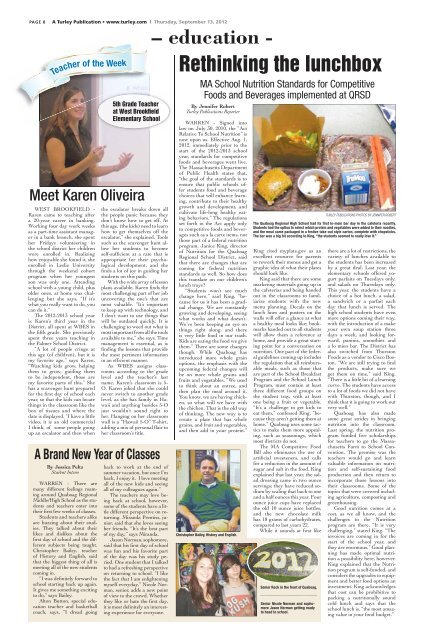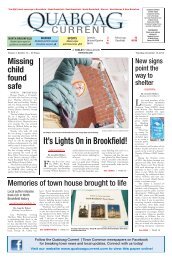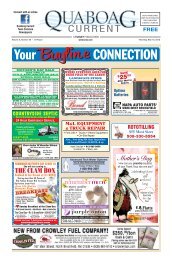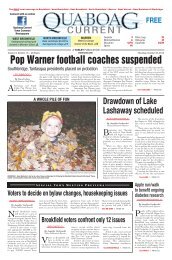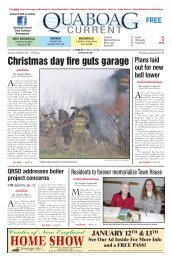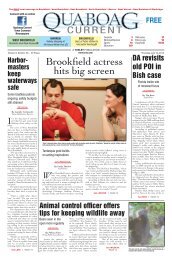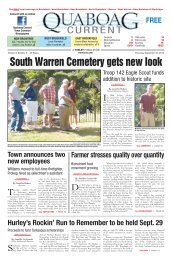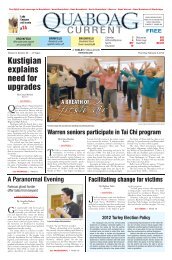September 13, 2012 pdf edition - Quaboag Current
September 13, 2012 pdf edition - Quaboag Current
September 13, 2012 pdf edition - Quaboag Current
You also want an ePaper? Increase the reach of your titles
YUMPU automatically turns print PDFs into web optimized ePapers that Google loves.
PAGE 8 A Turley Publication • www.turley.com I Thursday, <strong>September</strong> <strong>13</strong>, <strong>2012</strong><br />
– education -<br />
Teacher of the Week<br />
WEST BROOKFIELD -<br />
Karen came to teaching after<br />
a 20-year career in banking.<br />
Working four day work weeks<br />
as a part-time assistant manager<br />
in a bank branch, she spent<br />
her Fridays volunteering in<br />
the school district her children<br />
were enrolled in. Realizing<br />
how enjoyable she found it, she<br />
enrolled in Leslie University<br />
through the weekend cohort<br />
program when her youngest<br />
son was only one. Attending<br />
school with a young child, plus<br />
older ones, at home was challenging<br />
but she says, “If it’s<br />
what you really want to do, you<br />
can do it.”<br />
The <strong>2012</strong>-20<strong>13</strong> school year<br />
is Karen’s third year in the<br />
District, all spent at WBES in<br />
the fi fth grade. She previously<br />
spent three years teaching in<br />
the Palmer School District.<br />
“A lot of people cringe at<br />
this age (of children), but it is<br />
my favorite age,” says Karen.<br />
“Watching kids grow, helping<br />
them to grow, guiding them<br />
to be independent, those are<br />
my favorite parts of this.” She<br />
has a scavenger hunt prepared<br />
for the fi rst day of school each<br />
year, so that the kids can locate<br />
things in the classroom like the<br />
box of tissues and where the<br />
date is displayed. “I have a little<br />
video, it is an old commercial<br />
I think, of some people going<br />
up an escalator and then when<br />
5th Grade Teacher<br />
at West Brookfi eld<br />
Elementary School<br />
Meet Karen Oliveira<br />
the escalator breaks down all<br />
the people panic because they<br />
don’t know how to get off. At<br />
this age, (the kids) need to learn<br />
how to get themselves off the<br />
escalator,” she explained. Tools<br />
such as the scavenger hunt allow<br />
her students to become<br />
self-suffi cient at a rate that is<br />
appropriate for their psychological<br />
development, and she<br />
fi nds a lot of joy in guiding her<br />
students on this path.<br />
With the wide array of lesson<br />
plans available, Karen fi nds the<br />
most challenging part of her job<br />
uncovering the one’s that are<br />
most valuable. “It’s important<br />
to keep up with technology, and<br />
I don’t want to use things that<br />
will be outdated quickly. It is<br />
challenging to weed out what is<br />
most important from all the tools<br />
available to me,” she says. Time<br />
management is essential, as is<br />
fi nding the lessons that provide<br />
the most pertinent information<br />
in an effi cient manner.<br />
As WBES assigns classrooms<br />
according to the grade<br />
level and the teacher’s last<br />
name, Karen’s classroom is 5-<br />
O. Karen joked that she could<br />
never switch to another grade<br />
level, as she has family in Hawaii<br />
and anything besides 5-O<br />
just wouldn’t sound right to<br />
her. Hanging on her classroom<br />
wall is a “Hawaii 5-O” T-shirt,<br />
adding a mix of personal fl air to<br />
her classroom’s title.<br />
A Brand New Year of Classes<br />
By Jessica Peltz<br />
Student Intern<br />
WARREN - There are<br />
many different feelings roaming<br />
around <strong>Quaboag</strong> Regional<br />
Middle/High School as the students<br />
and teachers enter into<br />
their fi rst few weeks of classes.<br />
Students and teachers alike<br />
are buzzing about their studies.<br />
They talked about their<br />
likes and dislikes about the<br />
fi rst day of school and the different<br />
subjects being taught.<br />
Christopher Bailey, teacher<br />
of History and English, said<br />
that the biggest thing of all is<br />
meeting all of the new students<br />
coming in.<br />
“I was defi nitely forward to<br />
school starting back up again.<br />
It gives me something exciting<br />
to do,” says Bailey.<br />
Alton Button, special education<br />
teacher and basketball<br />
coach, says, “I dread going<br />
back to work at the end of<br />
summer vacation, but once I’m<br />
back, I enjoy it. I love meeting<br />
all of the new kids and seeing<br />
all of my colleagues again.”<br />
The teachers may love being<br />
back at school, however,<br />
some of the students have a little<br />
different perspective on returning.<br />
Miranda Prentiss, junior,<br />
said that she loves seeing<br />
her friends. “It’s the best part<br />
of my day,” says Miranda.<br />
Jason Norman, sophomore,<br />
said that his fi rst day of school<br />
was fun and his favorite part<br />
of the day was his study period.<br />
One student that I talked<br />
to had a refreshing perspective<br />
on returning to school. “I like<br />
the fact that I am enlightening<br />
myself everyday,” Nicole Norman,<br />
senior, adds a new point<br />
of view to the crowd. Whether<br />
they like or hate the fi rst day,<br />
it is most defi nitely an interesting<br />
experience for everyone.<br />
Rethinking the lunchbox<br />
MA School Nutrition Standards for Competitive<br />
Foods and Beverages implemented at QRSD<br />
By Jennifer Robert<br />
Turley Publications Reporter<br />
WARREN - Signed into<br />
law on July 30, 2010, the “Act<br />
Relative To School Nutrition” is<br />
now upon us. Effective Aug. 1,<br />
<strong>2012</strong>, immediately prior to the<br />
start of the <strong>2012</strong>-20<strong>13</strong> school<br />
year, standards for competitive<br />
foods and beverages went live.<br />
The Massachusetts Department<br />
of Public Health states that,<br />
“the goal of the standards is to<br />
ensure that public schools offer<br />
students food and beverage<br />
choices that will enhance learning,<br />
contribute to their healthy<br />
growth and development, and<br />
cultivate life-long healthy eating<br />
behaviors.” The regulations<br />
set forth in the Act apply only<br />
to competitive foods and beverages<br />
such as a la carte items, not<br />
those part of a federal nutrition<br />
program. Janice King, director<br />
of Nutrition for the <strong>Quaboag</strong><br />
Regional School District, said<br />
that there are changes that are<br />
coming for federal nutrition<br />
standards as well. So how does<br />
this translate on our children’s<br />
lunch trays?<br />
“Students won’t see much<br />
change here,” said King, “because<br />
for us it has been a gradual<br />
change. We are constantly<br />
growing and developing, seeing<br />
what works and what doesn’t.<br />
We’ve been keeping an eye on<br />
things right along, and there<br />
is very little food in our trash.<br />
Kids are eating the food we give<br />
them.” There are some changes<br />
though. While <strong>Quaboag</strong> has<br />
introduced more whole grain<br />
options, the emphasis with the<br />
upcoming federal changes will<br />
be on more whole grains and<br />
fruits and vegetables. “We used<br />
to think about an entree, and<br />
then plan the meal around it.<br />
You know, we are having chicken,<br />
so what will we have with<br />
the chicken. That is the old way<br />
of thinking. The new way is to<br />
create a plate that has whole<br />
grains, and fruit and vegetables,<br />
and then add in your protein.”<br />
Christopher Bailey, History and English.<br />
King cited myplate.gov as an<br />
excellent resource for parents<br />
to rework their menus and get a<br />
graphic idea of what their plates<br />
should look like.<br />
King said that there are some<br />
marketing materials going up in<br />
the cafeterias and being handed<br />
out in the classrooms to familiarize<br />
students with the new<br />
menu planning. Decals on the<br />
lunch lines and posters on the<br />
walls will offer a glance at what<br />
a healthy meal looks like; bookmarks<br />
handed out to all students<br />
will allow them a reference at<br />
home, and provide a great starting<br />
point for a conversation on<br />
nutrition. One part of the federal<br />
guidelines coming up includes<br />
the regulation that all reimbursable<br />
meals, such as those that<br />
are part of the School Breakfast<br />
Program and the School Lunch<br />
Program, must contain at least<br />
three different food groups on<br />
the student tray, with at least<br />
one being a fruit or vegetable.<br />
“It’s a challenge to get kids to<br />
eat them,” confessed King, “because<br />
they aren’t getting them at<br />
home.” <strong>Quaboag</strong> uses some tactics<br />
to make them more appealing,<br />
such as seasonings, which<br />
most districts do not.<br />
The MA Competitive Food<br />
Bill also eliminates the use of<br />
artifi cial sweeteners, and calls<br />
for a reduction in the amount of<br />
sugar and salt in the food. King<br />
explained that last year, the salad<br />
dressing came in two ounce<br />
servings; they have reduced sodium<br />
by scaling that back to one<br />
and a half ounces this year. Four<br />
ounce juice cups have replaced<br />
the old 10 ounce juice bottles,<br />
and the new chocolate milk<br />
has 18 grams of carbohydrates,<br />
compared to last years 22.<br />
While it sounds at fi rst like<br />
TURLEY PUBLICATIONS PHOTOS BY JENNIFER ROBERT<br />
The <strong>Quaboag</strong> Regional High School had its fi rst lo-mein bar day in the cafeteria recently.<br />
Students had the option to select which protein and vegetables were added to their noodles,<br />
and the meal came packaged in a festive take-out style carton, complete with chopsticks.<br />
The bar was a big hit according to King, “the students seemed to really love it.”<br />
Senior Rock in the front of <strong>Quaboag</strong>.<br />
Senior Nicole Norman and sophomore<br />
Jason Norman getting ready<br />
to head to school.<br />
there are a lot of restrictions, the<br />
variety of lunches available to<br />
the students has been increased<br />
by a great deal. Last year, the<br />
elementary schools offered yogurt<br />
parfaits on Tuesdays only,<br />
and salads on Thursdays only.<br />
This year, the students have a<br />
choice of a hot lunch, a salad,<br />
a sandwich or a parfait each<br />
day that lunch is served. The<br />
high school students have even<br />
more options coming their way,<br />
with the introduction of a make<br />
your own soup station three<br />
days a week, and looking forward,<br />
paninis, smoothies and<br />
a lo mien bar. The District has<br />
also switched from Thurston<br />
Foods as a vendor to Cisco Boston.<br />
“We are still trying to fi nd<br />
the products, make sure we<br />
get them on time,” said King,<br />
“There is a little bit of a learning<br />
curve. The students have access<br />
to a lot of foods we did not have<br />
with Thurston, though, and I<br />
think that it is going to work out<br />
very well.”<br />
<strong>Quaboag</strong> has also made<br />
some great strides in bringing<br />
nutrition into the classroom.<br />
Last spring, the nutrition program<br />
funded fi ve scholarships<br />
for teachers to go the Massachusetts<br />
Farm to School Convention.<br />
The premise was the<br />
teachers would go and learn<br />
valuable information on nutrition<br />
and self-sustaining food<br />
production and then return to<br />
incorporate those lessons into<br />
their classrooms. Some of the<br />
topics that were covered including<br />
agriculture, composting and<br />
greenhousing.<br />
Good nutrition comes at a<br />
cost, as we all know, and the<br />
challenges to the Nutrition<br />
program are there. “It is very<br />
challenging,” stated King. “The<br />
invoices are coming in for the<br />
start of the school year, and<br />
they are enormous.” Good planning<br />
has made optimal nutrition<br />
a possibility here, however.<br />
King explained that the Nutrition<br />
program is self-funded, and<br />
considers the upgrades to equipment<br />
and better food options an<br />
investment. King acknowledges<br />
that cost can be prohibitive to<br />
packing a nutritionally sound<br />
cold lunch and says that the<br />
school lunch is, “the most amazing<br />
value in your food budget.”


